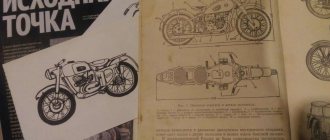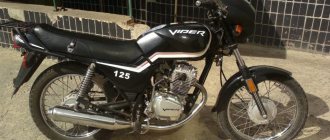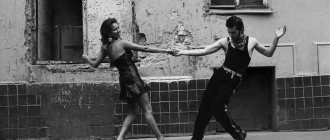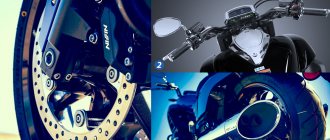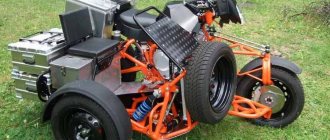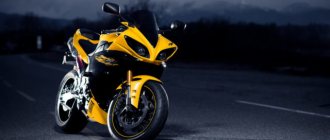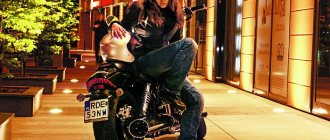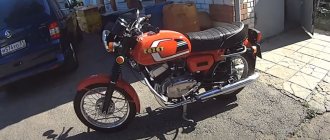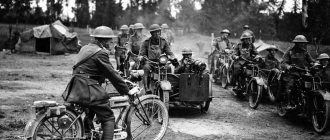Victory Motorcycles – photo gallery
12 archival photographs of motorcycles that participated in the Great Patriotic War.
It is no secret that the heavy Soviet motorcycle M-72 was “spied” on the enemy - it is an almost exact copy of the German R71 from ]BMW[/anchor]. Industrial espionage was a completely justified decision in wartime conditions: firstly, there was an urgent need to urgently organize the assembly of special army motorcycles, and there were no suitable developments in the USSR at that time, and secondly, the BMW R71 was extremely popular in the Wehrmacht and won in terms of reliability, endurance and characteristics in state interdepartmental tests conducted by the Main Armored Directorate of the Red Army among 15 motorcycles of various classes and models.
1. The first M-72 motorcycles, manufactured in Moscow, are sent to the front. End of 1941.
5 R71s secretly purchased in Sweden launched the production of more than 8,500 M-72 series vehicles, produced from 1941 to 1960 and not available for public sale until the mid-50s. The motorcycle was produced both in a single version and with a sidecar. The model was actively equipped with various additional equipment and was produced in a variety of modifications.
2. M-72 with a DShK heavy machine gun mounted on a sidecar
Production was launched in the shortest possible time and was repeatedly postponed - the offensive of the invaders forced the evacuation of entire factories with equipment and unfinished motorcycle components, as well as the use of all available human resources - women, old people and schoolchildren.
One shift at the plant lasted an average of 10-12 hours, production worked around the clock.
3. Motorcycle M-72, equipped with a special bracket for a PPSh machine gun. Judging by the form, the photo was taken before 1943.
The military also really needed imported motorcycles - Soviet industry in 1941–1942 did not at all meet the real needs of the Red Army. More than 20,000 motorcycles with sidecars, which were in service with these countries, were urgently purchased. These were mainly Harley-Davidson and Indian motorcycles.
4. Harley-Davidson WLA-42 with mortar
Soviet experts noted imperfect design and increased fuel consumption on Harleys, as well as the low power of Indian engines compared to the BMW R71.
5. Red Army soldiers inspect captured DKW RT350 - the ancestor of the IZH-350.
Motorcycle squads played an important role in the theater of war. In a big war, there are no trifles - motorcycle units, having great mobility, firepower and cross-country ability, are capable of solving a variety of tasks on the front line.
6. Motorcycle TIZ AM-600 and armored car BA-10 - a motorcyclist delivers a package during the Finnish War.
Motorcyclist units, together with tank troops, delivered serious blows to the enemy, disrupting communications and weakening enemy activity in important sectors of the front.
7. Forced march of a tank division and a motorcycle detachment.
In October 1941, when the Nazis were rushing to Moscow, a dangerous situation was created in one of the directions for our units.
To eliminate the enemy breakthrough, the 36th motorcycle regiment was called in, covering more than 500 kilometers in 19 hours without stopping or resting. For four days, until reinforcements arrived, the regiment held the line and stopped the fierce attacks of German troops.
8. Winter march of the motorcycle squad
After tanks broke through enemy defenses at Stalingrad, the 8th Motorcycle Regiment, acting as the advance detachment of a large tank formation, raided deep into the advancing German troops and paralyzed the enemy rear, “bleeding” the attack.
9. Soviet children and soldiers of the motorcycle troops of the Red Army.
Motorcycles were an indispensable means of transportation, communications, reconnaissance, and also helped troops hold terrain captured from the enemy and acted as separate combat units.
10. Reconnaissance motorized squad.
Put on the assembly line in just a year, the M-72 has proven itself in the best possible way in the most difficult conditions. Until 1943, it was prohibited to make changes to the design borrowed from the BMW R-71.
11. Deep snow and liquid mud are one of the few misfortunes that seriously interfere with the passage of heavy motorcycles with sidecars. During the war years, about 30 thousand motorcycles were imported into the Soviet Union from abroad - almost twice as many as they produced their own M-72s. But, despite the difficulties of mastering the new production and the hastily borrowed design of the M-72, the motorcycle played a huge role in the great Victory. This experience seriously advanced the country’s motorcycle technology and the “descendants” of the M-72 survived the USSR, still being produced in Russia under the Ural brand.
The most authentic Ural models to the ancestors are the M70 with a sidecar and the Retro-Solo.
12. Motorcycles of liberation soldiers on the streets of Bucharest.
In the early 50s, the M-72 was often modernized, and if at the Ural plant the Ural motorcycle replaced the M-72 already in 1961, the Kiev “opposite” survived on the assembly line until the 80s.
Video review of the M-72 motorcycle:
Motorcycles of the Second World War. The image of a former enemy.
Maxim MARKIN, Krasnoyarsk, photo from the archive of Mikhail SHESTAKOV and the author
In the 30-40s, Zundapp received an order for the production of heavy motorcycles with a 3x2 wheel arrangement. During the war it produced the KS750 (above left).
Motorcycles of World War II can no longer be divided into “us” and “them.” Time heals, and after a certain point the symbolism with eagles and crosses no longer hurts so painfully. Rarities bristling with machine-gun barrels are now just part of the history of technological progress. In Krasnoyarsk, in the house run by Mikhail Shestakov, a well-known motor restorer in Russia and Europe, it is especially easy to track this story.
The result of restoration, in the understanding of Mikhail Shestakov, can only be this: the restored car must be absolutely authentic. He remembers how he once, out of ignorance, attached something like door handles to the cartridge boxes (those that were attached to strollers). This offense was mercilessly condemned by the antique community! I learned a lesson for life. Since then, Shestakov has considered such liberties unacceptable.
Mikhail Dmitrievich Shestakov, in his early fifties. Mechanical engineer by profession. Weapons expert. Participates in biker festivals and reenactments of World War II battles.
The only “non-standard” items in his collection of motorcycles are tires, the insides of batteries (from Japanese scooters, dressed in housings similar to the original), and even wiring and some fasteners - variations with them are acceptable in the restoration world. The rest should match. And it matches! In order not to change the principle, one has to resort to technologies that can be called high not only by the standards of a small workshop. Mikhail Dmitrievich achieves the ideal surface of aluminum parts by treating them with a “glass-stream” - glass beads 150 microns in size. Casts pistons, fragments of engine crankcases and gearboxes. Once, when repairing a transmission, in order to make gears, we even had to analyze the metal. All the bolts on his “junk” are made in the image and likeness of those that were once produced by the Ribe company, but for this the restorer made dies (this is the most delicate work for a qualified toolmaker), and also used a 20-ton press. Try repeating the shape of the welds, recreating the load-bearing structures with millimeter accuracy...
Shestakov “caught a craving for motor retro” when he was given a 1938 BMW R35 for his birthday. It happened twenty-five years ago. Now in his collection there are 22 pieces of equipment from the pre-war era, 12 of them have been restored to the condition “yesterday from the assembly line”. All are expensive, but there are still favorites - the “Germans”.
The R75 Sahara rolled off the BMW assembly line. Interestingly, the two leading German companies managed to achieve extensive unification of models. Engines and gearboxes were also interchangeable.
It's a pleasure to work with them. They are from a world where scrupulousness and precision, in a word, Ordnung, are held in high esteem. Parts are of the highest quality processing, mating is a perfect fit... Structurally German
motorcycles are designed to best suit front-line conditions. The same R35 was originally designed for the most severe conditions. The heavy flywheel of the 340 cc 14-horsepower single-cylinder engine hardly accelerated the car, but the torque effectively “pulled” off-road. There are three R35s in Shestakov’s collection: in the army feldgrau color scheme and in the civilian color scheme - black, with white markings on the wings and frame. In the Wehrmacht, the R35 was more often used as messenger transport, like other light and medium-sized motorcycles. In the German army, “two-stroke” engines were neglected, but vehicles with four-stroke engines were “called up for service” without any exceptions. You look at the BMW R4 and wonder how such a miracle of engineering managed to not only serve, but even participate in competitions. And why did Joseph Goebbels himself like the motorcycle? No, everything is fine with the engine - one cylinder, 400 cc, 12 liters. With. But the rear suspension is just springs under the seat. But the front one is the height of technical perfection of those years: a quarter-elliptic spring.
L-300 “Red October” is the first production Soviet motorcycle, copied from the DKW 300 Luxus.
More than 50 different models of motorcycles were “accepted” for military service before World War II in Germany. It’s clear that it was accepted by the old guard, who remembered the cavalry. But this equipment also met the requirements of the young command staff, who “designed” mobile warfare, modern for that time. The motorcycle in the Wehrmacht received combat specialties. Serious hopes were placed on the BMW R12 released in 1935. The car was “reproduced” in a fairly large “circulation” - 36,000 copies, and there were reasons for this. Possessing an impressive margin of safety and good traction, it transported ammunition and other cargo. The motorcycle, equipped with an MG-34 machine gun, served in reconnaissance and patrol. Thanks to the design subtleties incorporated into it, the operation of the device was extremely convenient. Thus, there were adapted stretchers for transporting the wounded. Although the R12 did not have a rear suspension, it carried a sidecar (by the way, sometimes a very exotic one, from Royal, whose joints were not welded, but rolled), suspended on intricately curved springs, and, for the first time in world practice, was equipped with a telescopic fork. Its 750 cc boxer engine with a power of 18 hp, which in the military version lost one of two carburetors, started easily and worked in cold weather, since the intake tract was heated by exhaust gases. What more does a fighter need! What else does the Wehrmacht need?
The BMW R4, produced from 1932-36, was the forerunner of the R35. The model made a unique contribution to the Nazis’ rise to power: it was on this motorcycle that Goebbels made his propaganda raids around the country.
At the very beginning of the war, when Germany did not lack either funds or resources, the highest army officials considered that special forces needed special equipment. And they began to supply it to the troops in the fall of 1940. The collectible BMW R75 and Zundapp KS750 are Shestakov’s pride: un-motorcycle wide tires, three cartridge boxes. But why are they sandy and with palm tree symbols? Does BMW also have its own name - Sahara? Initially, the Germans intended to use both vehicles in two military guises - in parachute operations for transporting light recoilless rifles (this motorcycle was clearly not capable of doing this, and after the capture of the island of Crete, Hitler practically abandoned its use in airborne capture operations) and in offensive marches Erwin Rommel's Afrika Korps. The latter explains the coloring, as well as the presence of unusually voluminous air filters in the design. The vehicles were transferred from the “dark continent” to the Eastern Front, and here they found, perhaps, the best use.
These are full-fledged all-climbs. For both, the drive to the sidecar wheel is only a visible off-road attribute. To understand what extra weight is attached to the 3x2 wheel arrangement, it is enough to understand the levers - and you understand that there is also a differential lock and a reduction range. If you know that the car has a 26-horsepower 750 cc boxer engine, you begin to understand how impressive its potential and wide possibilities are. It is known that in the Red Army, a captured Zundapp or BMW was perceived as a gift. They even carried magpie guns (Zundapp was equipped with a standard trailer). The towing capacity extended to the point that domestic “one and a half trucks” were rescued from the mud with trophies!
True restorers take the position that all elements, even bolts, must be copied down to the last tenth of a millimeter. In the top photo on the right is a “native” bolt from Ribe, on the left is one made by Shestakov.
These “tractors” had one obvious drawback: each device in production cost twice as much as a Volkswagen kübelwagen - an army vehicle. That’s why both the R75 and the KS750, which were distributed mainly to the SS troops and reconnaissance, produced very little—according to various estimates, from 16 to 18 thousand units. Taking into account the significant combat losses of the Nazis in equipment, they are exclusive in our time.
For this reason, collector Shestakov managed to find BMW only in the form of “spare parts” (Mikhail even had to create a frame “from scratch”), and one of the three Zundapp copies he obtained remained a mystery to the master. Judging by the appearance and configuration, in which hands it has been: there is “collective farm tuning”, some domestic units, for example, a generator from “Belarus”. But the uniqueness of this junk is that it has the original frame, fork and engine from the BMW R75. The restorer would have been left with the impression of the motorcycle as a figment of someone’s sick garage imagination, if he had not come across information that such a “hybrid” was produced in industrial batches. And not in Germany: immediately after the war, such “I don’t understand what” ones were produced at one of the factories near Moscow and sold to the population. The frame was chosen from the KS750, because it had a high level of rigidity, the “telescope” was from BMW: it was believed that it was better and more convenient than the Zundapp parallelogram fork - it was unnecessarily complex in design, and in addition required frequent maintenance. But why was the R75 engine used - after all, the KS750 boxer had a cylinder angle of 170 degrees? Still, the Zundapp cylinders are higher from the ground - some kind of increase in geometric cross-country ability.
When starting the engine in low temperatures, we used a flask of fuel like this, with a special container attached to it for injecting gasoline into the carburetor.
It must be said that pre-war German designers, in addition to achieving purely technical tasks, also took care of attributes that would make the life of a motorcyclist-soldier easier. Shestakov pays tribute to the very convenient brackets for cartridge boxes - with them the boxes can be removed very quickly. The collector values little things and accessories - he does not consider the restoration complete until he has recreated the full “battle option”. Which, admittedly, is no match for the Soviet option of the same times. It’s simply amazing that German motorcyclists were given celluloid disposable glasses in paper bags, special bulbs and flasks with which gasoline was injected into the carburetor if the engine was started in cold weather. In the end, canisters: after the war, our industry reproduced them one after another and produced them in series, except perhaps without the stamped German markings on the sides. All these things and gizmos are also in the collection of the Krasnoyarsk collector.
He studies them and believes that sometimes the Germans unnecessarily complicated the designs: “You look at the diagram of the Notek blackout headlight and realize that they could well have had ordinary light bulbs. And look how cumbersome the machine gun mounts and the wheelchair turret are!.. I think the huge funds that were allocated to the German military-industrial complex before the war inspired the developers to sky-high flights of technical imagination. And sometimes the final product was brought to the point of absurdity.”
In the vast majority of cases, motorcycles with two-stroke engines were not subject to mobilization in Germany. Vehicles with “four-stroke” engines were taken into the army without any exceptions; even light equipment with an engine displacement of 250 “cubes” was “called up.” The photo shows a 340 cc BMW R35 (this example is already a civilian one, produced in 1950).
The Soviet soldier also had the opportunity (at least theoretically) to become familiar with a good motorcycle kit. Lend-lease equipment was supplied from the allies with all the appropriate attributes. Alas, leather jackets, gloves and other uniforms went to officers and political instructors, and the private received a “naked” motorcycle. From America - Harley-Davidson WLA42.
It’s a beautiful, even impressive car in its own way, with bags and a holster made of buffalo leather. But it is not entirely adapted to our conditions. Arriving in neat boxes lined with tar paper on the inside, Harley was quite disappointed with the quality of workmanship of the external parts - everything was covered in burrs and burrs. It frayed a lot of nerves for our military! The ground clearance is insufficient; the “American” had to be attached to a sidecar from the M-72, but this additional load often twisted the WLA42 frame like a “propeller.” However, we must pay tribute to the designers from the USA: the tubular elements, soldered with brass, never tore. A fairly powerful (750 cm3, 22 hp) four-stroke V-shape, whose connecting rods sat on one crank, provided, especially in the “solo” version, good running properties. However, the engine “didn’t like high temperatures.” The rear cylinder, covered by the front one, was poorly blown with air, as a result of which the engine overheated and seized. Here's what's interesting: when it cooled down, it started and worked.
A huge number of different motorcycles were placed at the disposal of the Wehrmacht. The main one was the BMW R12. To make it more fully consistent with military conditions, one of the two carburetors was removed from the design, causing the engine power to drop from 20 to 18 hp. With. The model's know-how is a telescopic fork, heated intake tract with exhaust gases, and a stroller suspension with intricately curved springs. Since 1943, when Soviet aviation gained air supremacy, motorcycle sidecars have been equipped with a Notec blackout device with a very complex system of mirrors.
At low temperatures it was very difficult to start - the oil in the gearbox located in a separate block froze, the gearbox could not be heated by the heat from the engine. Added to this were the inconveniences of repairs. Let's say the ignition coil was “hidden” so carefully that if it burns out, you won’t be able to find it or get close to it.
For lack of anything better, the WLA42 was good and loving. Fortunately, the allies from overseas supplied spare parts for it in abundance. You can still find new ones, packaged in beautiful boxes and generously oiled paper. If we finish talking to the end, we have to note: the Thompson submachine gun (the beautiful “buffalo” holster was intended for it) was supplied with only two magazines.
Due to the acute shortage of vehicles in the Red Army, the Harley-Davidson WLA42 became very popular, although in terms of technical equipment it was far from fully meeting the conditions of combat operations.
What did we have of our own? And this can be seen in Shestanov’s collection: Soviet specialists “copied” motorcycles from foreign models. The M-72, the twin brother of the BMW R71, was mass produced. The collector’s collection includes both: the first is awaiting restoration, while work on the second is in full swing. Other pre-war ones - TIZ AM-600 and L-300 "Red October" - went to Shestakov in excellent condition for their age. The L-300's former owners took it out piece by piece from the boxes into which it had been placed at the beginning of the war by an official leaving for the front. I didn’t want, you know, to give my favorite motorcycle to the army. True, this clone from the DKW 300 Luxus (early 30s) turned out to be useless as a warrior. How much could a single-cylinder engine of 300 cc with a power of only 6 “horses” do? The troops wanted to turn the 600 cc TIZ into Rambo. In the version without a sidecar, it was planned to install a Degtyarev tank machine gun on the steering wheel of the AM-600. The idea was an absolute utopia, and, of course, nothing came of it. TIZ was “assigned” to another, useful job - he successfully replaced the horse.
The collector believes that he is obliged to bring his “Red October” and AM-600 to “conveyor” condition. The same awaits several Zundapp and DKW models - these are more damaged by time than by battles. Even if they are on the move and at least partially, they have retained their originality - in this form, the Krasnoyarsk resident believes, they are just raw materials. Only after the restoration course, when the rarities take on their finished form, will “Shestakov-restoration” signs be hung on them. It's like your own Quality Control Department stamp. It should be noted that it is recognized both in the Baltic states - the cradle of restoration art throughout the former USSR, and in the Old World.
Motorcycles, go! Two-wheeled cavalry of the Red Army
Two-wheeled cavalry of the Red Army / Photo: img-fotki.yandex.ru
During the Great Patriotic War, motorcycles were actively used by German troops. But not many people know that there were 41 motorcycle regiments in the Red Army, six of which became guards.
Photo art16.ru
In the Moscow region, along with samples of modern military equipment, one could get acquainted with a large number of exhibits of retro equipment. Many visitors to pavilion 20 probably did not pass by the unique exhibition of military motorcycles from the Great Patriotic War of 1941-1945. Here you could see motorcycles of the famous brands BSA WM-20 and IMZ M-72, Harley Davidson WLA-42 and BMV R-75, Zundap RS-750 and MV-750 (K-750 “Dnepr”) of domestic and foreign production. Motorcycles of unusual design in the steampunk style and those created based on the game “War of the Worlds” aroused constant interest.
Steampunk style motorcycle / Photo: IA “ARMS OF RUSSIA”, Anatoly Sokolov
Motorcycle based on the game “War of Thrones” / Photo: IA “WEAPONS OF RUSSIA”, Anatoly Sokolov
The “motorcycle” retro exposition also featured a rare exhibit from the collection of the “Night Wolves” motorcycle club – a cable-laying motorcycle from the 8th separate motorcycle regiment.
The interest in this exhibition is not surprising and quite understandable. After all, almost every film about the Second World War has scenes in which the Germans act on motorcycles. However, today not many people know that 41 motorcycle regiments operated against the Germans as part of the Red Army, 6 of which became guards. One of them was the 8th separate motorcycle regiment (OMP) under the command of Pyotr Alekseevich Belik
.
Photo: yandex.ru
The regiment was formed in Transbaikalia (Manchuria) and in August 1940, under the command of Major Belik, became part of the 5th Mechanized Corps. In May-June 1941, the regiment of the 16th Army of the Kyiv Military District received baptism of fire in the first days of the war. In August 1941, the regiment became part of the consolidated detachment of the 22nd Army, and subsequently - the consolidated brigade (division) of the 29th Army. Subsequently, the regiment participated in the Battle of Smolensk and in the Battle of Moscow. In October 1941 - August 1942. The regiment was restoring combat effectiveness in the Baygushi area (Vladimir district). In August 1942, the 8th infantry regiment went to the front as part of the 5th Tank Army and was in the active army until May 9, 1945.
Motorcycle of the 8th separate motorcycle regiment type BMW R-75 / Photo: IA “ARMS OF RUSSIA”, Anatoly Sokolov
The 8th infantry rifle became famous on the Southwestern Front during the operation to defeat German troops at Stalingrad. On the very first day of the Soviet offensive, a regiment with a company of T-34 tanks and anti-tank artillery entered the breakthrough and from November 19 to 28, 1942, completely separated from the main forces in the deep rear of the enemy, destroyed its headquarters, communications and suitable reserves.
As a result of his actions, in 8 days, up to 800 were killed and 1,100 enemy soldiers and officers were captured, 7 warehouses with ammunition and food, 247 vehicles, 14 tanks, 16 self-propelled and 15 anti-tank guns, 11 aircraft were destroyed, the railway was disabled and a communication line on the Stalingrad-Likhaya section. The regiment freed 850 people from captivity and formed 8 partisan detachments of 30-50 people each.
Photo / img-fotki.yandex.ru
At the same time, 8 OMP lost only 26 people and 3 motorcycles. On the ninth day, the regiment linked up with the advancing units of the front. For this raid on December 18, 1942, the regiment was transformed into the 3rd separate guards motorcycle regiment, and in February 1943 its commander, Lieutenant Colonel Pyotr Belik, was awarded the title of Hero of the Soviet Union.
General Pyotr Belik / Photo yandex.ru
Belik Petr Alekseevich
(6.10.1909-12.06.1980) native of the village. Zhukovitsy, Kyiv region, Ukraine. Army General, Hero of the Soviet Union. He graduated from the Kyiv Infantry School (1930), the Moscow Armored Courses (1932), and the Higher Academic Courses at the Military Academy of the General Staff (1953). In the Red Army since 1927, at the front since June 1941. In 1943, he took part in the battles near Kharkov and the battle for the Dnieper. After completing the short-term Higher Academic Courses at the Military Academy of Armored Forces of the Red Army (1944), he returned to the regiment and participated in the liberation of Belarus and the East Prussian offensive operation. In the post-war period, he served as first deputy commander-in-chief of the GSVG and commander of the troops of the Western Military District (1966-1979), and then in the Group of Inspectors General of the USSR Ministry of Defense. Awarded the Order of Lenin (3), the October Revolution, the Red Banner (4), “For Service to the Motherland in the Armed Forces of the USSR” 3rd degree, medals and foreign orders.
A separate motorcycle regiment during the war was intended to conduct reconnaissance, develop success and solve other problems. To do this, he was equipped with the latest weapons and equipment for those times. The composition and number of units of the regiment were determined by the tasks being solved and were not constant. The staff of the Red Army motorcycle regiment dated June 22, 1941 provided for the presence of 1,417 people, 389 and 45 motorcycles with and without sidecars, respectively, 17 armored vehicles, six 45-mm anti-tank guns and 24 (50-mm) mortars. Each motorcycle with a sidecar carried, as a rule, 3 soldiers with carbines (machine guns) and a light machine gun.
Heavy motorcycle MV-750 (later K-750 “Dnepr”) with a sidecar.
Was in service with the Signal Corps / Photo: IA “ARMS OF RUSSIA”, Anatoly Sokolov Technical information
BSA
WM -20
is a British army motorcycle, which was supplied to the Red Army under Lend-Lease. In addition, it was in service with Australian, British and New Zealand troops. For the period 1937-1955. 126,000 units produced. With a weight of 176 kg and an engine power of 13 hp. could move at a maximum speed of 90 km/h.
Motorcycle BSA WM-20 / Photo: IA “ARMS OF RUSSIA”, Anatoly Sokolov
IMZ M-72
- domestic heavy motorcycle. In the period from 1941 to 1960. produced (Irbit) 330,000 units. From 1941 he entered the army, and from 1954 he entered the national economy. 22 hp engine ensured the movement of a motorcycle weighing 110 kg with a maximum speed of 110 km/h.
Heavy domestic motorcycle IMZ M-72. Reached Berlin and Prague / Photo: IA “ARMS OF RUSSIA”, Anatoly Sokolov
Harley
Davidson WLA -42
is a military version of the American civilian motorcycle of the WL series. It differs from the civilian model in the presence of a powerful rear trunk for transporting a radio station and a case for a Thompson assault rifle, as well as blackout lights. Produced in the USA from 1942 to 1945. With a weight of 230 kg, the engine produces 24 hp. provided a maximum speed of 110 km/h.
American motorcycle Harley Davidson WLA-42 / Photo: IA “ARMS OF RUSSIA”, Anatoly Sokolov
BMV R -75
is a German-made motorcycle with an all-terrain sidecar. In the period from 1941 to 1946. 18,000 cars were produced. Created taking into account the experience of military operations in 1940 in the Balkans and the Middle East. It had a spare wheel, compartments for storing equipment and ammunition, and a swivel on the sidecar for a machine gun. Crew – 2-3 people. With a mass of 420 kg, the engine produces 26 hp. ensured movement at speeds of up to 95 km/h.
Motorcycle BMV R-75 / Photo: IA “ARMS OF RUSSIA”, Anatoly Sokolov
Motorcycle Zundapp KS-750 / Photo: IA “ARMS OF RUSSIA”, Anatoly Sokolov
Zundap
RS -750
is a German motorcycle for use in severe off-road conditions. Produced in Germany and for the period from 1940 to 1948. 18,695 units produced. Delivered to Rommel's corps in Africa and other theaters of war. 25 hp engine ensured the movement of a motorcycle weighing 420 kg at speeds of up to 95 km/h.
MOSCOW, WEAPONS OF RUSSIA, Anatoly Sokolov www.arms-expo.ru 1
